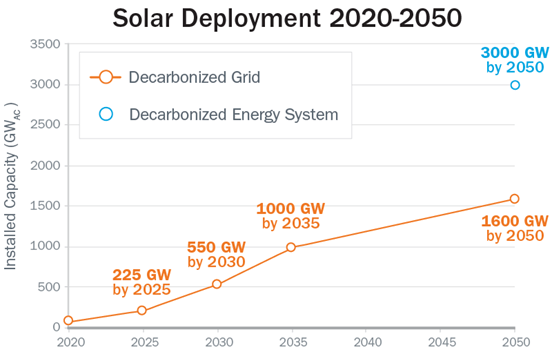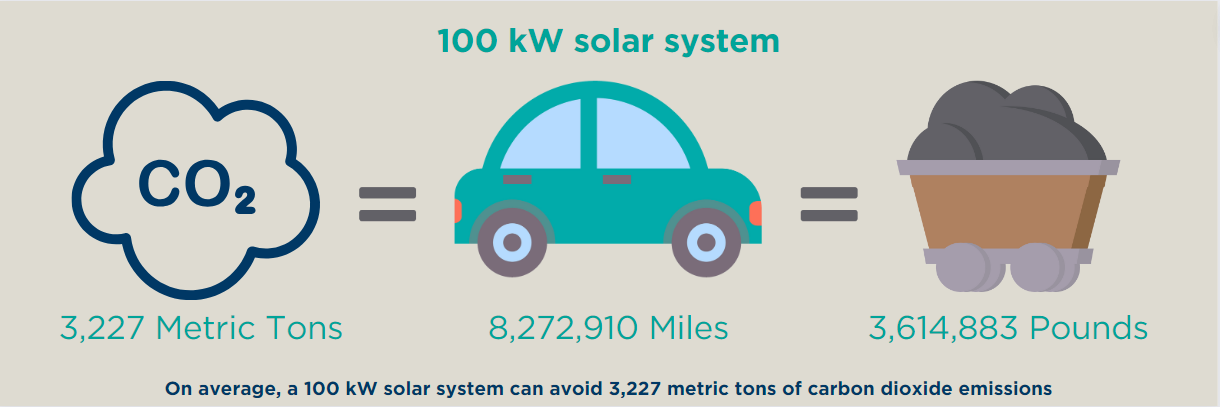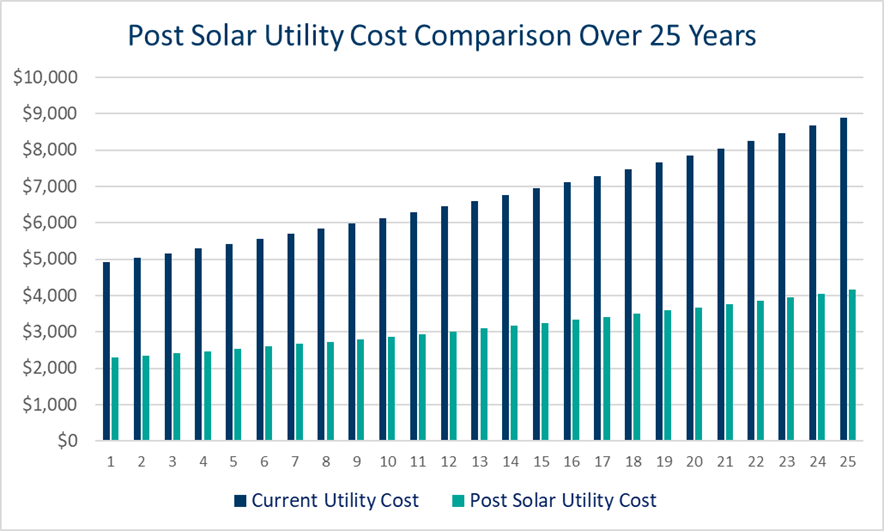Renewable energy systems offer numerous benefits for customers, some of which are realized within the first year of installation while others grow over time. Increasing understanding of the long-term advantages of renewable energy is driving rapid expansion in the sustainable energy market, particularly solar PV. It is projected that solar energy, with aggressive cost reductions, supportive policies, and large-scale electrification, could potentially contribute up to 40% of the nation’s electricity supply by 2035, and 45% by 2050.
Solar is already the fastest growing energy resource in the United States as a result of larger capacity additions and favorable tax credit policies. The tax credits and other funding help solar projects achieve an incredible return on investment, but many businesses are also incentivized by more long term, nonfinancial benefits as well.

Lower Energy Costs
The immediate benefit of a solar PV system is the direct energy offset from producing your own energy. Energy produced via a rooftop array, parking lot canopy, or grount mount array of solar panels goes straight to the business’s operations and reduces the amount of energy purchased from the power company. Colite Technologies’ customers have seen energy offsets anywhere from 20% to over 100% for their facilities. This averages out to savings of nearly $15,000 per year in energy expenses!
As a whole, the industry standard for the performance life of a solar PV system is around 25 to 30 years. This means that a solar system installed today will continue to produce energy for the next 25 to 30 years with routine maintenance. Therefore, when the energy savings are calculated over a 25-year period, the total comes to more than $370,000 for each customer.
Not only does solar directly reduce your energy use, but many utilities also offer programs that ensure excess energy generated by the solar system is not wasted. Net metering is a common option that power companies use to pay or credit a customer for any electricity that is fed back to the grid. It usually utilizes a bi-directional meter that measures both electricity consumed by the facility and unused electricity that goes to the grid. The utility then calculates the net consumption and bills the customer accordingly. This is particularly beneficial for times where the solar system is generating more energy than the building uses, and you, the building owner, can get paid for the surplus power.
Don’t forget about tax credits!
Other long-term benefits of commercial solar are tax credits and rebates that can be leveraged in your business’s finances. There are numerous tax credits from federal and state governments for renewable energy investments, the most popular one being the business Investment Tax Credit (ITC).
The Inflation Reduction Act significantly expands and builds upon the ITC with extended eligibility and bonus credits for meeting additional criteria. Taking advantage of multiple tax credits helps decrease the initial costs of installing a solar system and spreads the remaining costs over time.
Risk Mitigation
Investing in solar power offers the reassurance that a portion of energy expenses is shielded from rising energy prices. From 2021 to 2022, commercial electricity rates increased 6.2% and industrial electricity rates jumped 8.7%. Utility companies will continue to increase rates in the future as they upgrade equipment, infrastructure, or build entirely new generation units to meet higher demand. However, since a solar PV system is owned by the property owner in most cases, any electricity produced from solar is not subject to utility rate increases. This eliminates uncertainty in fluctuating energy costs and provides a reliable source of power that is controlled by the owner.
Onsite solar also proves beneficial in instances such as power outages. As long as the sun is shining, the solar panels will be generating electricity and can keep your critical operations going. Now, you may think, “What if the power outage is during the night?” Battery energy storage technology is rapidly evolving and becoming much more practial to pair with solar PV. The batteries can store the energy produced by the solar panels during the day and have it available when needed. However, this option is mostly applicable to smaller energy users. It is not quite viable for large energy users, like manufacturing plants, because the battery techonology is not there yet. On the other hand, if you are serious about your energy independence, microgrids paired with battery energy storage can be an option for small scale uses. Again, keep in mind that microgrids are limited by available battery technology and do best when using diversified energy sources.
Long-Term Sustainability
Environmental sustainability is another key driver for businesses investing in solar energy. Many companies have robust sustainability goals that include reducing greenhouse gas emissions and using less resources to help lessen their impact on the natural environment. There is a growing urgency to address climate change and the pressure from consumers, particularly younger generations, is reaching the top levels of organizations. Further, an increasing number of businesses are subject to climate reporting and must measure, track, and report on their carbon footprint.
A solar installation, whether rooftop, canopy, or ground mount, provides multiple benefits to the environment by reducing the amount of energy procured from the utility. A majority of utility power plants burn natural gas to generate electricity – contributing to about 34% of total energy-related carbon dioxide emissions in the US in 2021. Therefore, by avoiding utility electricity, you reduce the amount of greenhouse gases put into the atmosphere and shrink your environmental impact.
For example, a 100kW solar PV system avoids 3,227 metric tons of CO2 emissions over 25 years. To put this into perspective, this amount is equivalent to the emissions resulting from driving 8,272,910 miles in a standard gasoline-powered vehicle or burning 3,614,883 pounds of coal. Over time, these reductions lead to improvements in air quality, wildlife habitats, and critical ecosystems. As a bonus, if the solar panels are on the rooftop of an existing building, there is no physical impact on the surrounding land and preserves local greenery.

Still Worried About the Long-term?
When you work with Colite Technologies, our team will develop a commercial solar PV system design that meets your building’s needs and include an economic model overviewing the 25-year performance of the system. We will help you visualize energy production as well as identify any tax credits or grant funding that would be applicable to your project. The graph below is an example of one aspect of the economic model developed by Colite Technologies. The model illustrates the comparison between annual utility costs and annual utility costs after installing a solar system over a 25-year period, assuming an average annual electricity price escalation of 2.5%. It immediately shows the significant financial savings that solar energy offers in the long run. As long as the sun shines, you will have a free energy resource to generate onsite electricity.

If you are looking for long-term cost savings, risk management strategies, smaller environmental footprint, or all of the above, solar could be a great solution for your facility. Here at Colite Technologies, we make sure that your solar system is designed to maximize your benefits and performs for years to come. You can be confident that your investment in a commercial or industrial solar project is fully evaluated for the long-term and supports you, your business, and the environment.

